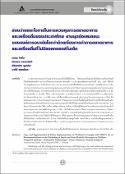บทคัดย่อ
การทำการตลาดและการโฆษณาอาหารและเครื่องดื่มที่มีน้ำตาล ไขมันและเกลือสูงเป็นปัจจัยแวดล้อมสำคัญที่มีอิทธิพลต่อพฤติกรรมการบริโภคอาหารและสุขภาพของเด็ก การประชุมสมัชชาอนามัยโลกปีพ.ศ.2553 ได้มีมติรับรองชุดข้อเสนอแนะว่าด้วยเรื่องการทำการตลาดอาหารและเครื่องดื่มที่ไม่มีแอลกอฮอล์ในเด็ก โดยให้ดำเนินการระดับโลกในการสนับสนุนกระบวนการทางนโยบายและกลไกอันจะนำไปสู่การลดผลกระทบต่อเด็กจากการทำการตลาดอาหารที่มีไขมันอิ่มตัว กรดไขมันทรานส์ น้ำตาล หรือเกลือในปริมาณสูง ชุดข้อเสนอแนะนี้ประกอบด้วยเนื้อหา 12 ข้อ จำแนกออกเป็น 5 ประเด็น ได้แก่ 1.ที่มาและเหตุผล 2.การพัฒนานโยบาย 3.การนำนโยบายไปใช้ 4.การติดตามและประเมินผลนโยบาย และ 5.การวิจัย บทความนี้เป็นการศึกษาสถานการณ์ ช่องว่างและโอกาสของกฎหมาย ระเบียบ ข้อบังคับและมาตรการในการควบคุมการตลาดและการโฆษณาอาหารและเครื่องดื่มในเด็กของประเทศไทยที่สอดคล้องกับชุดข้อเสนอแนะว่าด้วยเรื่องการทำการตลาดอาหารและเครื่องดื่มที่ไม่มีแอลกอฮอล์ในเด็กขององค์การอนามัยโลก โดยวิเคราะห์ในสามประเด็น ได้แก่ กลไกการพัฒนานโยบาย กลไกการนำไปปฏิบัติและกลไกการติดตามและประเมินผล ทั้งนี้ จากการทบทวนสถานการณ์ด้านกฎหมาย ระเบียบ ข้อบังคับและมาตรการในการควบคุมการตลาดและการโฆษณาอาหารและเครื่องดื่มในเด็กภายในประเทศไทย สรุปได้ว่า ประเทศไทยมีกฎหมายเกี่ยวกับการทำการตลาดและการโฆษณาอาหารที่สามารถนำไปปรับใช้ได้บางส่วน เพื่อควบคุมการสื่อสารการตลาดและการโฆษณาอาหารและเครื่องดื่มที่มีไขมันอิ่มตัว กรดไขมันทรานส์ น้ำตาล หรือเกลือในปริมาณสูงในเด็ก อย่างไรก็ตาม การบังคับใช้กฎหมายดังกล่าวยังไม่มีประสิทธิภาพและประสิทธิผลเท่าที่ควร และยังขาดกฎหมายเฉพาะการทำการตลาดและการโฆษณาอาหารและเครื่องดื่มในเด็ก
บทคัดย่อ
Marketing and advertising of food and beverages with high sugar, fat, and sodium are important
environmental factors which influence on children’s eating behavior and health. In 2010, the World Health Assembly, the World Health Organization (WHO) Member States endorsed a set of recommendations on
the marketing of foods and non-alcoholic beverages to children, aiming to reduce the impact of foods high
in saturated fats, trans fatty acids, free sugars, or salts, and expecting cooperation at policy level. The
structure of this document includes a description of the background and process for the development of
the recommendations, an evidence section and 12 recommendations structured under five sub-headings:
1. rationale; 2. policy development; 3. policy implementation; 4 policy monitoring and evaluation; and 5.
research. This study describes theoretical concepts of the set of recommendations, situations, gaps, and
opportunities of food and beverages marketing and advertising regulations in Thailand which correspond
to these recommendations, and analyses 3 mechanisms: policy development; policy implementation and
policy monitoring and evaluation. The review of regulations to control food and non-alcoholic beverage
marketing and advertising to children in Thailand found that Thailand has laws related to marketing and
advertising, which can be deployed to control the marketing and advertising of foods and non-alcoholic
beverages high in saturated fats, trans fatty acids, free sugars, or salt in children. However, the law enforcement
is not as efficient and productive as it should be and there is also a lack of specific regulation to
control food and non-alcoholic beverage marketing and advertising to children.


